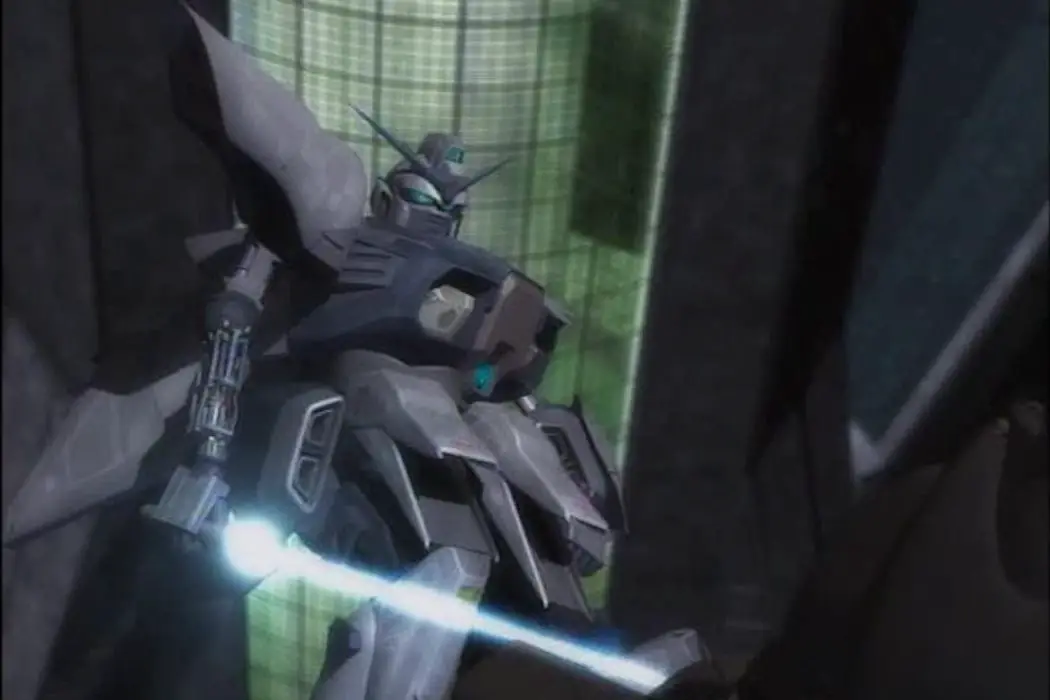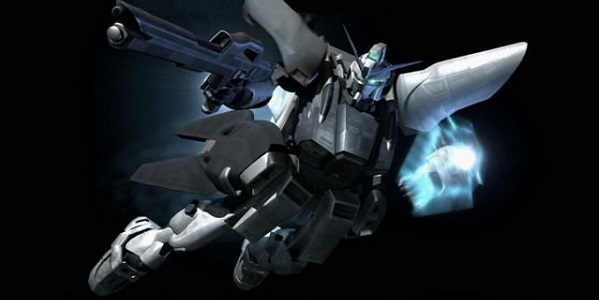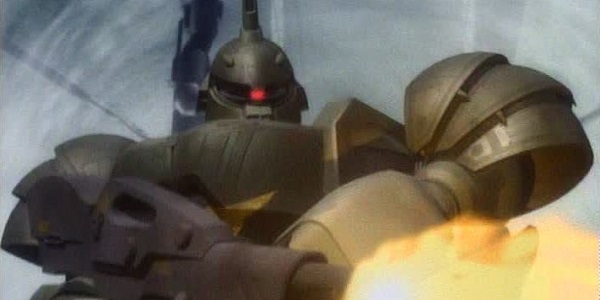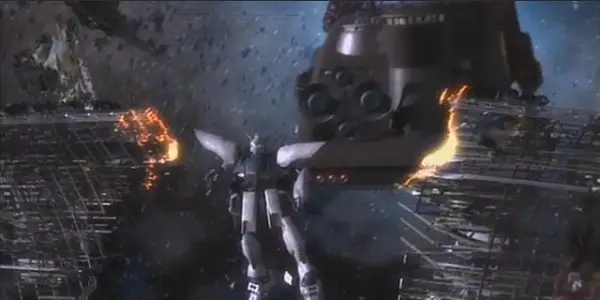G-SAVIOUR: A Japanese TV Special Made In Canada

A former video store clerk, Mark has been writing about…
Though Mobile Suit Gundam had become an anime staple in Japan since its debut in 1979, the franchise wouldn’t become a notable hit in the United States until the early 2000s. While a number of Gundam series had made small home video debuts in the late 1990s, it wasn’t until the spin-off series Gundam Wing debuted on Cartoon Network in Spring of 2000 that Gundam started to become a more notable name among Americans.
It wasn’t long before the popularity of Wing expanded to debuting other Gundam series on Cartoon Network, including the original albeit remastered 1979 Mobile Suit Gundam TV series. Strangely, however, one Gundam property that never aired on the channel was a live-action Gundam TV-special, G-Saviour, that was made in Canada and spoken in English. It would only debut on Japanese television with a Japanese dub.
The 20th Anniversary
After twenty years, Gundam had grown as a massive franchise in Japan. Though the initial series was prematurely canceled, theatrical compilation movies that debuted in the early 1980s gave new life to Gundam. The show and movies were a real game-changer of the giant robot genre, favoring more of a wartime drama than superhero action, where the man-made colonies of outer space fight for independence against the Earth forces with mecha.
Though the original Mobile Suit Gundam borrowed much of its inspiration from Star Wars, from Char Aznable’s Darth Vader style helmet to Newtype pilots essentially being Jedi, it would quickly become its own thing as it expanded. The success of the theatrical trilogy led to multiple sequel series (Gundam Zeta, Gundam ZZ), side-story miniseries (Gundam 0080: War in the Pocket), and strange spin-offs of fighting tournaments (G Gundam) and pretty-boy dramas (Gundam Wing).

By the time the 20th anniversary was nearing, the Sunrise corporation that has been crafting the Gundam anime decided to do something special by announcing a series of new media under the banner of the “Gundam Big Bang Project.” Their most notable celebratory project was Turn-A Gundam, marking the return of Gundam creator Yoshiyuki Tomino at the helm after years of absence and mechanical designs by legendary designer Syd Mead (Blade Runner).
It was also a bit of a mind-bending show chronologically, considering Tomino suggests it takes place not in an alternative universe but one universe that converges all the Gundam properties together. I guess that’s one way to tie everything together in an anniversary special.
The lesser acknowledged project would be G-Saviour, a live-action Gundam TV special. This was very ambitious, considering a live-action Gundam movie had never been done before, with the exception of cinematic sequences from the video game Gundam 0079: War on Earth. But it wouldn’t quite be the special many of the Gundam fans were hoping for.
The Production
G-Saviour was developed as part of a joint venture between the Gundam-owning Sunrise studio and the independent Canadian studio of Polestar Entertainment. While there’s no definitive answer as to why the production would be entirely in Canada, a likely motive was to keep the costs down considering the small talents assembled.
It was a very Canadian production of TV talents. The movie would be directed by Graeme Campbell, a rising TV director who would later go onto become an integral part of Canadian teen staple Degrassi: The Next Generation. The script written by Mark Amato and Stephanie Pena-Sy would still conform to the Gundam timeline, even if it was more by design than anything in the story relating too deeply to anything in the anime. Notice how in the film’s dialogue nobody once says the word Gundam, leading me to believe that this project may have been used to double as a generic sci-fi adventure that could be sold to North American television.

The cast was all TV talent. Brennan Elliott, known mostly for small guest spots and Lifetime series Strong Medicine, plays the generic hero. Kenneth Welsh, a TV movie veteran, plays the evil general. The more recognizable of names for the Gundam fans will be Enuka Okuma playing the love interest, better known at the time as the voice of Lady Une from Gundam Wing. Of course, nobody in Japan would get to hear her smooth voice, however, as all of these roles would be dubbed over by Japanese voice actors.
Perhaps the most famous name in the crew is John Debney, an accomplished composer who had crafted music for such films as Liar Liar and The Emperor’s New Groove. Debney would only compose the theme song, however, as rising TV composer Louis Febre would work on the rest of the soundtrack.
The Story
G-Saviour takes place within the main Gundam timeline of Universal Century but it doesn’t matter if you think you need to brush up on your Gundam to watch the film. The original Gundam series took place in Universal Century 0079 and the sequels and spin-off were usually not too distant to allow for returning characters and factions. G-Saviour, however, takes place in Universal Century 0223, so far in the future that little if anything remains relevant to the original anime.
The war between Earth and the space colonies still remains but with much different and goofier factions. Those factions are – and try not to snicker – the Congress of Settlement Nations (CONSENT), the Settlement Freedom League, and a resistance force known as the Illuminati. Mark Curran (Brennan Elliott) used to work for CONSENT as a pilot but now does underwater work for a corporation. When CONSENT starts taking over his lab and shooting up some intruders, Mark suspects something is up. He connects with the rebel fighter Cynthia Graves (Enuka Okuma) and soon comes around to her side when he discovers the scientific MacGuffin that CONSENT is trying to cover up. So it’s off to space to protect the MacGuffin and maybe fight a fleet of giant robots with the prototype mech, G-Saviour.

The tale is remarkably bland when compared to the likes of other Gundam series and features that usually delved into bigger themes of war and coming to terms with the past. G-Saviour is a starkly dull script in comparison, posing character cliches for a story more about some enzyme that can solve a food shortage than any greater focus on the nature of intergalactic politics. Mark is absolutely boring as a hired hero, Graves can do little more than spout desperate exposition to get the plot moving, CONSENT Lieutenant Colonel Jack Halle (David Lovgren) is your typical sneering rival of a pilot with a snobby face, and CONSENT General Garneaux (Kenneth Welsh) is a pompous villain in uniform complete with a laughable scream towards the camera when he meets his explosive demise.
The Giant Robots
Before you mark this film off as a strange failure of a Gundam movie, consider the special effects of the computer graphics used to generate the giant robot battles. We don’t see many giant robots for over half the movie; only small scenes with one robot each. The scenes look nice, especially when you consider these were computer graphics meant for a TV special in the year 2000, but they feel limited in their extent.

But then the third act comes along and something miraculous happens. There’s a battle between colony rebels and the CONSENT fleet, both sides wielding giant robots as they battle just outside a rotating space colony. There are now dozens of giant robots littering the screen in an explosive battle of lasers, gunfire, energy shields, explosions, and bullets piercing metal. These many shots, while not boasting the best of texturing, make great use of the limitations by staging the camera well. It’s easy enough to tell in this open space which robot belongs to which pilot and where they are in relation to the colony and the fleet.
The best showcase of these animations is when Mark and Jack have a mecha duel amid the battle. I remember being astounded when I saw the camera rotate and spin around the large colony engaged in war, cleverly settling on our hero and villain trading beam saber blows on the reflective solar panels of the colony. For a brief moment, I forgot about the Power Rangers level acting and generic adventure story lacking in character to enjoy a CGI mecha fight staged wonderfully.
G-Saviour: The Legacy
Though G-Saviour only made its television debut in Japan with dubbed in voices, the film did integrate into the Gundam franchise, despite being a distant sequel. A novel adaptation was published around the same time as the TV premiere, as well as a three-part radio drama. The story itself would continue in a video game for the Playstation 2, which would also continue further in a manga serial. And, of course, there were toys of the G-Saviour robot.
Surprisingly, G-Saviour has not been as well remembered or preserved as other Gundam properties. Many Gundam series in the past few years have been re-released on DVD and Blu-ray, including the 20th-anniversary series Turn-A Gundam. But since G-Saviour got no love over the years, the out-of-print DVD is the only way to see this strange product of the Gundam franchise; an English-spoken TV special that never found its way onto American television during perhaps the one time when Gundam was at its peak on Cartoon Network.
I’m honestly surprised it hasn’t been re-released, considering it’s not as towering a trainwreck as, say, the embarrassing American take of Roland Emmerich‘s Godzilla. But considering Sunrise hasn’t given the film a new release, maybe they feel differently.
Did you catch G-Saviour during the Gundam hype of the early 2000s? Let us know in the comments below.
Does content like this matter to you?
Become a Member and support film journalism. Unlock access to all of Film Inquiry`s great articles. Join a community of like-minded readers who are passionate about cinema - get access to our private members Network, give back to independent filmmakers, and more.
A former video store clerk, Mark has been writing about film for years and hasn't stopped yet. He studied film and animation in college, where he once set a summer goal to watch every film in the Criterion Collection. Mark has written for numerous online publications and self-published books "Pixels to Premieres: A History of Video Game Movies" and "The Best, Worst, Weird Movies of the 1990s."













